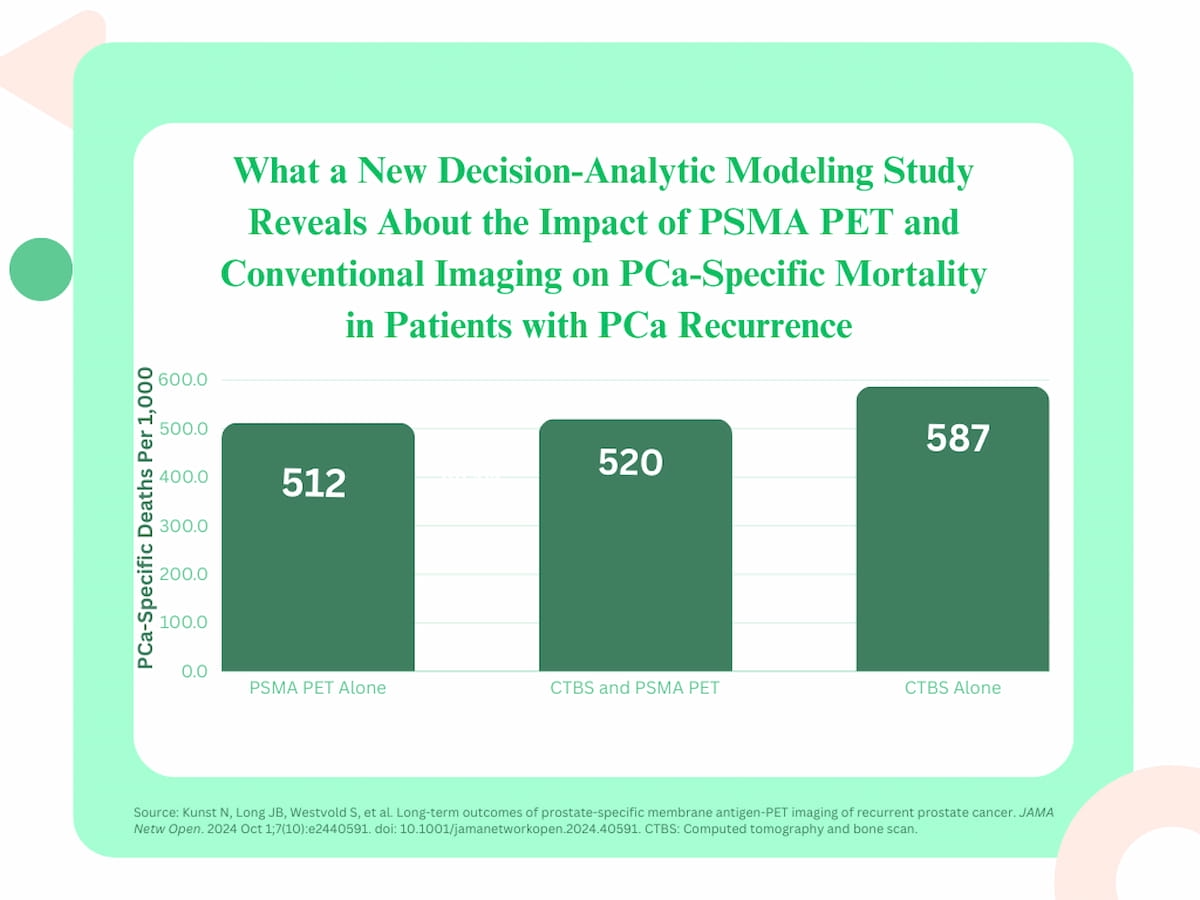New research suggests that prostate-specific membrane antigen positron emission tomography (PSMA PET) may facilitate significantly better detection of metastasis, quality of life and reduced mortality rates in contrast to conventional imaging for patients with prostate cancer (PCa) recurrence.
In a decision-analytic modeling study, recently published in JAMA Network Open, researchers compared estimated long-term outcome estimates for immediate use of PSMA PET; the use of computed tomography and bone scan (CTBS) and subsequent PSMA PET for inconclusive CTBS findings; and CTBS without PSMA PET for simulated patients with biochemical recurrence (BCR) of PCa.
Per 1,000 simulated patients with PCa BCR, the study authors estimated that immediate use of PSMA PET diagnosed 611 patients with metastasis in comparison to 297 patients diagnosed with CTBS only, suggesting that PSMA PET more than doubled the metastasis detection rate of CTBS. The researchers also estimated that the combination of CTBS and subsequent PSMA PET would lead to metastasis detection in 630 out of 1,000 patients with PCa BCR.
The study authors estimated that PSMA PET could facilitate 8,741 quality-adjusted life years (QALYs) in comparison to 8,609 QALYs for the combination CTBS and subsequent PSMA PET, and 7,917 QALYs for CTBS alone. The use of PSMA PET would also lead to 75 less prostate cancer specific deaths per 1,000 simulated patients with PCa BCR (512) in contrast to CTBS (587), and eight less PCa-specific deaths than the combination of CTBS and subsequent PSMA PET (520), according to the researchers.
“Our results suggest that use of PSMA-PET alone or as a reflex test following negative findings with conventional imaging is expected to detect more than twice the number of patients with metastatic disease and lead to the initiation of systemic therapy in more than 60% of patients imaged,” wrote lead study author Natalia Kunst, Ph.D., who is affiliated with the Center for Health Economics at the University of York in the United Kingdom and the Cancer Outcomes, Public Policy and Effectiveness Research Center at the Yale School of Medicine in New Haven, Ct., and colleagues.
(Editor’s note: For additional content on prostate cancer imaging, click here.)
In examining the impact of prostate-specific antigen (PSA) level, the researchers found the differences between PSMA PET and the other imaging options were more pronounced for simulated patients with PSA levels of > 5 ng/mL.
Three Key Takeaways
1. Improved detection of metastasis. PSMA PET imaging detects more than twice the number of prostate cancer metastases compared to conventional imaging (CTBS), according to the decision-analytic modeling study. Per 1,000 simulated patients with biochemical recurrence of PCa, PSMA PET identified 611 cases of metastasis versus 297 cases detected by CTBS alone.
2. Better quality-adjusted life years (QALYs). The study estimates that PSMA PET facilitates greater patient quality of life with 8,741quality-adjusted life years (QALYs) compared to 7,917 QALYs with CTBS alone. This indicates a significant improvement in health outcomes with PSMA PET.
3. Reduced mortality. PSMA PET imaging was associated with fewer prostate cancer-specific deaths. Estimates from the study suggested PSMA PET would prevent 75 more deaths per 1,000 patients with PCA recurrence than CTBS alone and additional estimates found that PSMA PET use would lead to 76 fewer deaths in comparison to CTBS alone in patients with higher PSA levels
In comparison to CTBS alone, PSMA PET yielded 1,035 more life-years (8,208 vs. 9,243), 856 more QALYs (6,313 vs. 7,169) and 76 less PCA-related deaths (697 vs. 621) per 1,000 simulated patients with PCa BCR, according to the study authors.
“Greater projected benefit among patients with higher PSA levels may be driven by wider diagnostic gaps in detection of radiographic disease between PSMA-PET and conventional imaging and associated differences in treatment initiation,” noted Kunst and colleagues.
(Editor’s note: For related content, see “Study: PET/CT Identifies PCa Recurrence in Over 75 Percent of Patients with Low PSA Increases After Radiotherapy,” “Can 18F-Flotufolastat Bolster Detection of PCa Recurrence in Patients with Low PSA Levels After Radical Prostatectomy?” and “PSMA PET/CT or mpMRI: Which is Better for Diagnosing Biochemical Recurrence of PCa?”)
In regard to study limitations, the authors acknowledged that the randomized clinical trials utilized to inform assumptions integrated into the evaluated model lacked PSMA-PET definitions of metastasis and employed first-line use of androgen deprivation therapy (ADT) monotherapy. The researchers cautioned against extrapolation of the study findings to broader populations due to the patient data being primarily drawn from those with lower prostate-specific antigen (PSA) levels, which has been associated with lower yield on conventional imaging.
